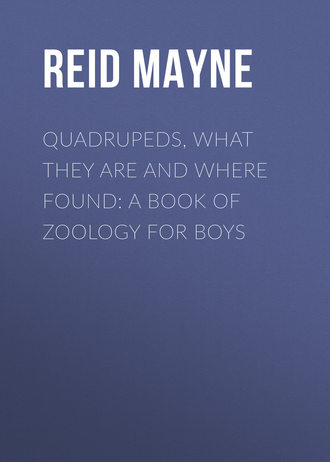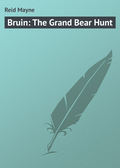
Майн Рид
Quadrupeds, What They Are and Where Found: A Book of Zoology for Boys
Chapter Eighteen.
The Ox Tribe
Our common domestic cattle furnish the type on which this family is founded; and it is well-known that of this type there are many varieties in different countries. Even in our own, so many are there, that a mere list of their names would fill one of our pages. We shall refrain therefore from giving any description of the different varieties – simply remarking that they are all supposed to spring from one original. This is, to say the least, a very doubtful hypothesis, since cattle have been found domesticated in many countries, and the period of their first introduction to the society of man is altogether unknown. It is far more likely that different species have furnished the varieties now known as domestic cattle.
We shall proceed to describe the other bovine animals – which, although of the same family, are beyond doubt of a distinct species from the common cattle.
The Zebu is one of the most remarkable. Its home is India and the adjacent regions; where it branches off into almost as many varieties as there are breeds of our own oxen. These varieties have different names; and they differ in size, shape, and other particulars; but the hump and long hanging dewlap render the zebu easily recognisable.
In India they are sometimes employed as beasts of the saddle and draught; and their flesh is also eaten, though with the exception of the hump (which is esteemed a great delicacy) it is not equal to English beef. Among the Hindus the zebus are regarded as sanctified creatures; and to slaughter them is deemed sin. For all that, these fanatics do not hesitate to work them – sometimes hard enough. There are some zebus, however, that are considered more holy than common. These may be seen wandering idly about the villages, fed from the hands of the people; and if neglected in this regard, they walk uninvited into the rice enclosures, and help themselves!
The zebus are usually of an ashy-grey colour, though many are white; and their size varies from that of an ordinary calf, to the stature of a full-grown bull.
There is a variety of the zebu – or perhaps a distinct species – known as the Dante. It is an African animal – that is, Egypt is the country where it is chiefly found. Very little knowledge of it exists among naturalists. It is distinguished from the Indian zebu by having a smaller hump upon the withers and a narrower face; and it is supposed to be the animal represented on the ancient Egyptian tombs.
We next come to the kind of oxen termed Buffaloes; and of these there are several species.
First, there is the Indian buffalo; and it may here be remarked, that when the word buffalo is used, an animal with a huge hump upon its shoulders is usually understood. This is an error, arising, no doubt, from the fact that the bison of America, which has a hump, is generally called a buffalo. But the Indian buffalo has no such protuberance; nor yet the African species. The Indian animal is found both in a domesticated and wild state; but both are clearly of the same species. The wild one is called the Arna, and the tame one Bhainsa, in the language of the natives. The former is of much greater size than the latter – standing, when full-grown, as high as the tallest man! So strong are these animals, that an arna bull has been known to butt down a good-sized elephant with a single stroke of his horns!
It is the Indian buffalo that is found in Italy – where it has been introduced, and is used for draught; its great strength giving it the advantage over horses, especially on the deep miry roads that exist in some parts of the peninsula.
The Manilla buffalo is a smaller variety or species of the arna, inhabiting, as its name imports, the Philippine Islands.
The African buffalo, sometimes known as the Kaffir buffalo, is another of these great oxen, and not the least celebrated of the tribe. It is an inhabitant of Africa, and is found chiefly in the southern half of that continent, from the Cape of Good Hope northwards. It is an animal of vast size and strength; often waging war with the lion, and frequently with man himself. In these encounters the buffalo is but too successful; and it is asserted among the natives of South Africa, that there are more deaths among them, caused by buffalo bulls, than by all the other wild beasts of the country. Like his Indian congener, the shock from the massive horns of an African buffalo is almost irresistible; and both the lion and elephant at times succumb to it.
There is a smaller African species about which less is known. This is the Zamouse or Bush cow, which differs from the true buffalo in having a flatter forehead, and being altogether without the dewlap.
We now come to the American buffalo, or Bison, as it should be called. This is indigenous to North America; and its present range is confined to the great prairies that extend eastward from the foot of the Rocky Mountains. It was formerly found much farther to the east – in fact, to the Atlantic coast; but its limits are now far beyond the meridian of the Mississippi. Hunters (both red and white) have driven it across the Rocky Mountains; and of late years it has been met with in the territory of the Upper Columbia. Its habits are too well-known to call for a description here, and its shaggy coat, with the deformity of its huge shoulder-hump, are familiar to every eye. With one exception, it is the only species of the ox tribe indigenous to America – and it may be added, to North America – since no native bovine animal is known to exist in the southern half of the Transatlantic continent.
The European buffalo– or as it is sometimes called Lithuanian buffalo– bears a considerable resemblance to that of the prairies. In size it is perhaps superior; but the two are much alike in general appearance – especially in their massive form, and the long brown hair, of woolly texture, so thickly set upon their necks and shoulders.
The European buffalo is nearly extinct, and exists only in some of the forests of Lithuanian Poland, where it is rather half-wild than wild; that is, it freely roams the forests, but only as the deer in our own extensive parks, or the white cattle, known as the wild Scotch oxen – in other words, it has an owner.
A very remarkable species is the Yäk, or Grunting Ox. This is found only in the high, cold countries that lie to the north of the Himalayan Mountains – in Thibet and Tartary. There is only one species, but this is both wild and tame – the wild sort being the larger and more formidable animal. The domestic variety is used by the people of Thibet for carrying burdens; and both its milk and flesh are in great demand in these cold countries of poverty and hunger.
The yäks dislike the warmth of summer; and during that season seek to hide themselves in the shade, or under water, in which they swim well. Their grunt exactly resembles that of a hog. The calves are covered with rough black hair like a curly-haired dog; but, when three months old, they obtain the long hair that distinguishes the full-grown animal, and which hangs so low as to give it the appearance of being without legs! They willingly live with common cattle, and will breed with them; but the wild yäk bull is an exceedingly fierce and dangerous animal. The tail of the grunting ox is very full, or bushy; and although the hair of the body is usually black, that upon the tail is universally of a pure white. This hair, when dyed red, is used by the Chinese to form the tufts worn in the caps of the mandarins. It is the chowry or fly-brush of India.
Like other domesticated cattle, the yäk is found of different breeds – known by the names of Noble yäk, Plough yäk, etcetera.
Next in succession comes the Musk Ox of America, which, from its long hanging hair, and also from many of its habits, bears a good deal of resemblance to the grunting ox. The musk ox is a native of North America; and there his range is confined to the most remote regions of the Hudson’s Bay territory. He is met with in the inhospitable track known as the Barren Grounds – and also along the coasts and islands of the Arctic Ocean – but nowhere so far south as the boundary of the United States or the Great Lakes. But for the land expeditions of several Arctic explorers, the existence of the musk ox would hardly have been known; and, as it is, his habits are but little understood. He is not of large size – being between the stature of an ox and a sheep – and in general appearance he resembles the latter more than the former; hence, among naturalists, he is styled the Sheep ox (ovibos). He and the Bison, as already remarked, are the only indigenous oxen of America.
To return to Asia. In its south-eastern parts – the Indies – we find several other species of the ox tribe. There is the Gayal or Jungly-gau, which inhabits the eastern parts of Bengal, especially the mountains that separate this province from Arracan. Of this there is a tame and wild species – the latter an inhabitant of forests, living rather upon the shoots of trees than upon grass. It is a large animal, more like the common ox than any of the buffaloes; and it is also less fierce in its disposition than the latter.
Next to the gayal is the Gam– also a forest-dwelling ox, of large size; and, like the other, browsing upon the leaves and twigs of trees.
The gam inhabits several forest-covered mountains in Central India, where it is only found wild. Attempts have been made to domesticate it, but without success – since it is both a shy and fierce animal; so much so that even the calves will not live in captivity!
Another Indian ox is the Takin, which inhabits the country of the Kamptis, in the eastern ranges of the Himalayas, and about which there is a dispute among naturalists, as to whether it is an ox!
We conclude our sketch with the Anoa, which belongs to Celebes – a small species bearing some resemblance to the antelopes; and the Banting or Sumatran Ox, a native of Java, Borneo, and also, as its second name denotes, of the Island of Sumatra.
Chapter Nineteen.
Sheep
The Sheep is one of the animals which man has subjected to his use; and one, too, of primary importance in the domestic economy of almost every civilised nation. Like the horse, dog, cat, ox, and pig, it has assumed the greatest possible variety. Many naturalists have treated these varieties as species; but those writers of greatest authority agree in considering all the domestic breeds as having originated from one common stock; and it would be idle here to speculate upon this question.
Of the tame sheep there are not less than forty very distinct kinds, besides numerous varieties of each of these kinds! These, of course, are distributed among many nations, and exhibit a very great difference in point of size and general appearance. Some are without horns, while others have these appendages very large, and of eccentric shape; some are covered with long crisp wool; others have the wool lank and straight; while still others have no wool at all, but instead a coat of hair resembling that of a spaniel or Newfoundland dog! But, besides these distinct kinds, as already stated, there are numerous varieties of each kind. For instance, the common sheep of England is itself branched out into quite as many as twenty breeds, each of which has a name of its own, and differs from all the others in many essential characteristics.
Leaving the common sheep of our own country, we shall say a few words of some of the more noted kinds that are in the possession of different nations abroad.
From Spain comes the Merino, so celebrated for the quality of its wool; while in Astracan and other Oriental countries there is a breed, the lambs of which furnish the well-known Astracan lambs’-skin, one of the most beautiful and valuable of furs. The Wallachian sheep, bred in Hungary, Transylvania, and the Danubian principalities, also produces a flue fur-like skin, much worn by the peasantry of Eastern Europe, in jackets and cloaks termed “bundas.”
A very similar kind of hairy-coated sheep is propagated throughout Asiatic Russia and Siberia – the skins affording a warm and comfortable clothing for the natives of these cold countries.
In the Indian countries there are many varieties, such as the Barwall of Nepaul, and also the Huniah, Cago, and Seeling, belonging to the same kingdom. Again, in the Deccan there is a breed known as Deccan sheep, another called Garar, and two others in Mysore denominated respectively the Carrimbar and Shaymbliar. China has a variety known as the Morvan, with very long legs; and in Russia, again, there is a kind with tails so long that their tops drag upon the ground; and another in Northern Russia, with tails so short that they appear altogether wanting!
With regard to tails, no breed has these appendages so developed as the broad or fat-tailed sheep. This kind is supposed to have originally come from Barbary; but they are now propagated in different parts of the world. In Asia they are found among the Tartars, Persians, Buchanans, and Thibetians. In Africa itself they are common among the Abyssinians, and are also kept in large flocks by the Dutch colonists of the Cape. The tails of these sheep are sometimes so large and heavy, that it is with difficulty the animals can carry them; and in some instances they are dragged along the ground as the sheep move from place to place! The fat of which this appendage is composed is esteemed a great delicacy; and at the Cape, as elsewhere, it constitutes an important article of the cuisine.
There are several other curious breeds of sheep reared in the different countries of Africa. These are, the Guinea sheep of the western coast; the Morocco sheep, bred in the kingdom of the same name; the African sheep, an inhabitant of the Sahara; and the smooth-haired African sheep. There are also the Tezzan sheep, belonging to Tripoli; the Saint Helena sheep, of the celebrated Island of Saint Helena; the Congo sheep, of Congo; and the Angolas, of the same region, famous for the quality of their wool – not to be confounded, however, with the Angora wool, which is the produce of a goat. There are sheep in Tartary that eat bones like dogs, and in Hindustan and Nepaul there are kinds that have four horns each. These are the Dumbas. A little species exists in Iceland, in which the horns sometimes grow to the number of eight – though four is the more common number. America, too, has its varieties. These are the Brazilian sheep, the Demerara breed, the South American sheep, and a variety known as the West Indian.
In fact, go to whatever part of the world you may, you will find a species or variety of this valuable animal, different in some respects from all the others.
The wild sheep, like the wild goats, do not number a great many species; but there are certainly several that are yet undescribed, and perhaps there may be about a dozen in all. No doubt the great central mountains of Asia, and also the ranges of Northern Africa, still unexplored, will in time yield several new species of wild sheep. Indeed, late travellers in the Himalayas speak of wild sheep that appear to be essentially different from the argali, and other species already known.
One species of wild sheep belongs to Europe – the Moufflon, which is to this day found plentifully in the mountainous parts of Corsica, Cyprus, and Candia. It was supposed to be the original of the tame breeds; but this is a mere conjecture.
In America there is also but one species of wild sheep, though it has also a variety. This is the Bighorn of the Rocky Mountains, lately much spoken of by prairie travellers and fur-hunters. It is not known in tropical North America, nor does its range extend to the Andes of the south; but it is found to the west, in the mountains of California, in a variety called the Californian sheep. The bighorn is extremely like the Asiatic argali, and was for a long time regarded as identical with the latter; but this was an error. It is now ascertained that not only is the American animal of another species, but also that there are several distinct species of the argali itself in the different ranges of Asiatic mountains.
Africa has its wild sheep, but only in its northern parts. This is the Aoudad, which dwells in the mountains of Barbary.
Asia appears to be the head-quarters of the wild sheep. One species is found in Armenia, and another in the Caucasus. Siberia has an argali, that appears altogether to differ from the argali of the Himalayas. Again, in the Himalayan Mountains themselves, there is one species which ranges north only as far as Thibet; while on the Thibetian plateaux, as far as the Altai Mountains, there is another, if not two other species, quite distinct from the latter.
It has been observed by competent travellers, that these Thibetian argalis bear a very strong resemblance to the different breeds of tame sheep found in the same regions; from which it may be reasonably inferred that the domesticated varieties of different countries have sprung from several wild species, instead of being all descended from one common origin.
Chapter Twenty.
Goats
My young readers will be surprised to hear that nothing is more difficult than to tell a Goat from a Sheep. Yet such is in reality the fact. Of course the common goat is easily distinguished from the common sheep; but then there are species and varieties of both these animals so like in shape, size, colour, and habits, that the most accomplished naturalists are unable to pronounce which are goats and which are sheep! Indeed, some naturalists make no distinction at all, but class both under the same genus. This, however, is not a correct view, since there is an essential difference in the nature of these two animals, notwithstanding the frequent resemblance in their outward appearance. It was upon this very point – their nature– that the renowned Buffon relied in separating them; he alleging that the sheep differed only from the goats in the greater gentleness and timidity of their disposition. It is true that this is not a very scientific mode of classification; yet, strange to say, it is held to be one of the safest guides for distinguishing the one from the other. Of course, it can only be relied upon when taken in connection with other indices of a physical character. Perhaps you may fancy that goats and sheep may be distinguished from each other by the “coat” – the former having a hairy coat, while that of the latter is woolly. For you who reside in the British Islands, this mark would stand good enough, since British goats are in reality clothed with hair, and British sheep with wool; but in many other countries the case is not only different, but directly the reverse, the goats being woolly, while the sheep are hairy!
It may be further remarked, that there are both goats and sheep so very nearly akin to antelopes, that it is again difficult to draw a line of distinction among the three. Indeed, there is a section of the antelope tribe, called the goat-antelopes, so called on account of this very approximation. Several species of antelopes – as the chamois of the Alps, and others – are by many naturalists classed as goats; and the bighorn of the Rocky Mountains, which is a true wild sheep, is also classed by some zoologists as a species of antelope.
The goats approach nearer to the nature of antelopes than do the sheep. In fact, the mountain antelopes are extremely like goats in their nature and habits. On this account the latter are supposed to stand between the sheep and antelopes.
We shall separate the goats into two kinds: first, the tame or domesticated goats; and secondly, the wild ones. Of the domesticated kind there is an endless list of varieties; and upon the question as to which of the wild species was the parent stock, thousands of opinions have been expressed, and long treatises written. It is just as with the dog, and other domestic animals – no one can certainly say what species was first introduced to the society of human beings; and it is far more likely that it was not any one wild species, but several, and belonging to different countries, that gave origin to the numerous kinds of goats now in the possession of man.
It would be a troublesome task to describe these numerous varieties. Every country has its kind; and, in fact, every district of country can show a breed distinct from all the others. Instead of specifying each breed, we shall only mention a few of the more noted and valuable sorts.
The Thibet or Cashmere goat is perhaps the most celebrated of the tribe; its celebrity arising from the fineness of its wool, out of which are manufactured the costly Cashmere shawls. An attempt was made to introduce this variety into England; but it has not been successful, though the cause of its failure has not been communicated to the public. We can easily find a very good reason in the fact, that a first-class Cashmere shawl requires a year in its manufacture; and therefore, if an English weaver were to have the raw material for nothing, his labour would amount to more than the shawl was worth in the market! It is just the same with the culture of the tea-plant. There are many districts in America where the tea-tree would flourish as well as in China; but what would be the use of growing it there, since the labour required to bring it to a state of readiness for the teapot would also raise it to an unsaleable price! These are the important principles that people who talk of protective duties entirely lose sight of.
The best Cashmere goats are brought from the Thibet country; and then wool sells for a rupee a pound in Cashmere itself. It is spun by the women, and afterwards dyed. The persons employed in making the shawls sit on a bench around the frame. If it be a pattern shawl, four persons labour at its manufacture; but a plain one requires only two. The borders are marked with wooden needles, there being a separate needle for each colour; and the rough side of the shawl is uppermost while it is being made.
The best shawls are manufactured in the kingdom of Cashmere itself, though many are made in other Oriental countries, and also in France; and the wool of several varieties of the goat, besides the Thibet, is used in the manufacture. In Cashmere alone 30,000 shawls are made annually – giving employment to about 50,000 people.
The Angora goat is another noted variety – esteemed for its fine silky hair. It inhabits the countries of Angora and Beibazar, in Asiatic Turkey, where it is kept in large flocks, the goatherds bestowing much care upon the animals – frequently combing and washing them!
The Syrian goat, remarkable for its excessively long ears, is reared in Aleppo and other parts of Asiatic Turkey, and is kept for the use of its milk, with which many of the towns are supplied.
There are other varieties less noted, among which may be mentioned the Spanish goats, without horns; the Juda, or African goat, with two hairy wattles under the chin; and the pretty little Whidaw goat – also a small African variety. There is also a Nepaul goat, and one belonging to the Deccan, called Bukee – a very large gaunt fellow, with long shaggy hair. The Irish goat, too, is a peculiar variety of the common or domestic species.
Tame goats are distributed very generally over all the Old World. They thrive well in the cold climate of Norway; and are equally at home in the hottest parts of Africa and the Indian islands. In America they are rare, in the territory inhabited by the Anglo-Saxon races – it not being considered a valuable speculation to “raise” them; but throughout the Spanish territories, both in North and South America, large flocks may be seen, and the wild goats of Juan Fernandez are descendants of these Spanish-American domesticated breeds.
The species of true wild goats are not numerous, but are very generally distributed over the world – particularly over the old continents. In America only one wild species is indigenous: that is, the Rocky Mountain goat. Some authors have asserted that this species is not indigenous to America; but most certainly this statement is an error. From its peculiar appearance, as well as from the locality in which it is found, it could never have sprung from any known domesticated breed. It is a long-haired creature, snow-white in colour, and with very short straight horns. Its hair is of silky hue and fineness, and hangs so low that the animal appears as if without legs. Its skin makes one of the most beautiful of saddle covers; and for this purpose it is used; but the animal itself being rare, and only found in the most remote and inaccessible regions of the Rocky Mountains, a good skin is as costly as it is valuable. It is met with in the great central range, from Northern Mexico, as far north as the Rocky Mountains extend; and it is supposed also to exist among the higher summits of the Californian mountains.
The Ibex is another species of wild goat, somewhat celebrated. It is the wild goat of the European Alps, where it is known by the Germans as Stein-boc, and as Bouquetin among the French.
Another ibex belongs to the Caucasian Mountains, called Zebudor, or Hach; and still another kind inhabits the Himalayas, where it passes under the name of Sakeen. There is also an ibex in Siberia; and still another in the Pyrenees.
In addition to these, there is a large wild goat in the loftiest Himalayas, known as the Jaral, or Tur; and another in India called the Jungle Kemas, or Wild Sheep of Tenasserim. In Northern Africa, again, there are several species of native wild goats, as the Jaela in Egypt, and the Walie of the African-Arab countries; but in South Africa no indigenous wild goats have been observed – their place in that region being supplied by their near congeners the Klipspringers, and other rock-loving antelopes.







